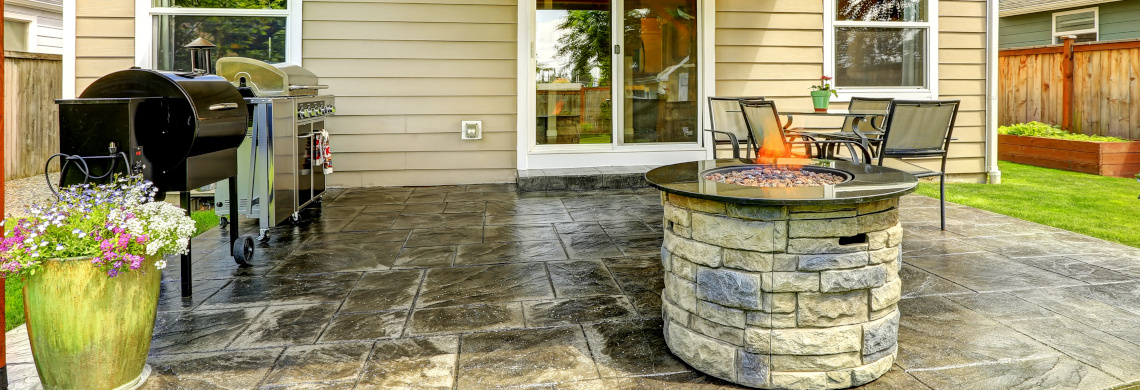Patios

Common Types of Patios, Porches, and Pergolas
1. Patios
A patio is an outdoor space typically used for dining, recreation, or relaxation. Here are some common types of patios:
a. Concrete Patios
Concrete patios are popular due to their durability and versatility. They can be customized to various shapes and sizes, and their smooth surface makes them easy to clean. Some benefits of concrete patios include:
- Durability and long lifespan
- Low maintenance
- Customizable design options
- Can be stamped or stained to mimic other materials
Tips for constructing a concrete patio:
- Ensure proper site preparation and excavation
- Use quality concrete mix and reinforcement
- Allow sufficient curing time
- Consider adding a sealant for protection
b. Brick Patios
Brick patios offer a timeless and elegant look to outdoor spaces. They are durable and can withstand heavy foot traffic. Some features and benefits of brick patios include:
- Classic and charming appearance
- Durable and long-lasting
- Available in various colors and patterns
- Low maintenance
Tips for constructing a brick patio:
- Prepare a stable base with proper drainage
- Ensure a level surface using sand or gravel
- Use a brick pattern that suits your design
- Secure bricks with a solid foundation and jointing sand
- Consider sealing the bricks to enhance longevity
c. Flagstone Patios
Flagstone patios provide a natural and rustic look to outdoor areas. They are typically made of flat, irregularly shaped stones. Key features and benefits of flagstone patios include:
- Natural and unique appearance
- Durable and weather-resistant
- Slip-resistant surface
- Can be laid in various patterns
Tips for constructing a flagstone patio:
- Prepare the base with compacted gravel or sand
- Lay the flagstones with proper spacing
- Fill gaps with gravel or polymeric sand
- Consider adding a sealant for protection and enhanced color
2. Porches
A porch is an extension of a building, typically at the front or back entrance, and provides a sheltered outdoor space. Let's explore some common types of porches:
a. Screened Porches
Screened porches are enclosed with mesh screens to keep out insects while allowing fresh air and sunlight. Some features and benefits of screened porches include:
- Protection from bugs and pests
- Improved ventilation
- Added privacy
- Shade from direct sunlight
- Additional living space
Tips for constructing a screened porch:
- Choose durable screen materials
- Ensure proper framing and support
- Consider adding a door for easy access
- Install ceiling fans or lighting if desired
b. Open Porches
Open porches are uncovered and offer an inviting space to relax and enjoy the outdoors. Some features and benefits of open porches include:
- Unobstructed views
- Natural ventilation
- Ample space for outdoor furniture
- Opportunity for creative design elements
Tips for constructing an open porch:
- Choose suitable flooring materials like wood or composite decking
- Ensure proper structural support
- Consider adding a roof or awning for shade and protection from rain
- Install outdoor lighting for evening use
3. Pergolas
A pergola is an outdoor structure typically consisting of vertical posts supporting crossbeams and an open roof. Here are some common types of pergolas:
a. Wooden Pergolas
Wooden pergolas add a touch of natural beauty to outdoor spaces. They can be constructed using various types of wood, such as cedar, redwood, or treated lumber. Some features and benefits of wooden pergolas include:
- Classic and timeless appearance
- Natural resistance to insects and decay (with certain wood species)
- Ability to be stained or painted in various colors
- Can be customized with decorative elements, such as lattice panels
Tips for constructing a wooden pergola:
- Choose durable and rot-resistant wood
- Ensure proper anchoring of posts
- Follow a sturdy construction design
- Consider applying a protective finish to extend the lifespan
b. Metal Pergolas
Metal pergolas offer a modern and sleek aesthetic to outdoor spaces. They are typically made of materials like aluminum or steel. Some features and benefits of metal pergolas include:
- Contemporary and stylish design
- Durable and long-lasting
- Low maintenance
- Lightweight and easy to install
- Can be powder-coated for enhanced protection and color options
Tips for constructing a metal pergola:
- Choose high-quality metal materials
- Ensure proper anchoring and stability
- Follow manufacturer instructions for assembly
- Consider adding climbing plants for natural shade and beauty
c. Retractable Pergolas
Retractable pergolas offer versatility by providing the option to control the amount of shade and sunlight. They typically feature a canopy or louvered system that can be adjusted as needed. Some features and benefits of retractable pergolas include:
- Flexible shading options
- Protection from rain
- Customizable levels of sunlight
- Added privacy
Tips for constructing a retractable pergola:
- Choose a reliable and easy-to-use retractable system
- Ensure proper installation of the canopy or louvers
- Consider motorized options for convenience
- Regularly maintain and clean the retractable components
Conclusion
Whether you're considering a patio, porch, or pergola, each option has its own unique features and benefits. Concrete, brick, and flagstone patios offer durability and customization, while screened and open porches provide various levels of protection and ventilation. Wooden, metal, and retractable pergolas offer different aesthetics and shading options. Remember to consider your specific needs, budget, and maintenance requirements when choosing the right option for your outdoor space. With proper planning and construction techniques, you can create a beautiful and functional area to enjoy outdoor activities and enhance your overall living experience.


